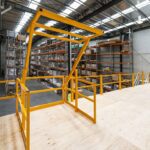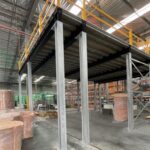
If you’re considering getting a mezzanine floor for your warehouse or factory, you may be considering a particular design or how it will be supported. The support structure of a mezzanine floor will change how much weight it can support, what it can be used for, and what can happen underneath the mezzanine floor.
Building and having a mezzanine floor in a warehouse or factory isn’t as simple as putting it up. Designing it is just as important. So before you just hop into it, consider all the different ways to support a mezzanine.
Mezzanines Supported By Pallet Racking
Supporting a mezzanine with pallet racking is common and practical. Ultimately a mezzanine is installed in a factory or warehouse in order to create more space, but it’s important that the space both above and below the the mezzanine is used as effectively as possible.
By using pallet racking to support a mezzanine, warehouse workers can still use the space below it as usual, while using the mezzanine above for anything else that’s needed. This may be for general shelving, storage, picking and packing, or even just an employee break area.
In this situation, where the mezzanine sits on top of pallet racking, business as usual is allowed to continue on the warehouse floor, while the vertical space above is used to its full potential.
Mezzanines Supported By Sigma Sections
Sigma sections are a modular way to build mezzanines. Because of this, constructing a mezzanine out of sigma sections can be done quickly. They also allow for long spans, which means less space is wasted from support structures on the ground.
All of this allows for a large amount of space to be used underneath the mezzanine itself; a space that can be used for almost anything. Building a mezzanine out of sigma sections may be useful if you’re planning on storing longer items underneath it, or even use it for something like vehicle parking; a situation where support columns may get in the way and make the space underneath less useful.
Although long spans can be useful for storage underneath the mezzanine, of course this limits the weight baring capacity of the mezzanine itself. This needs to be considered, depending on what you’re planning on using the mezzanine for.
Structural Steel Supported Mezzanines
If you’re after a completely customised mezzanine design, structural steel is the way to go. Structural steel is strong, allowing for good spans and a large amount of weight baring. The steel components can be manufactured off site and then assembled to build the complete mezzanine, so construction can be quick too, limiting the downtime to a business.
That being said, since structural steel mezzanines are completely custom, they need to be designed from scratch and can be more costly to create. This can be worthwhile if you require heavier duty storage on the mezzanine itself while also having a lot of space underneath.
A Combination Of All Three
A mezzanine floor design doesn’t need to limit itself to one type of support. This is a good option for mixed use mezzanines both above and below.
For example, one section of the mezzanine can be supported by pallet racking, allowing pallet storage. The other section of the floor can be either sigma sections or structural steel, allowing for longer spans for general storage underneath the mezzanine. From there, the use of the mezzanine floor itself is up to you.
What Are You Going To Use A Mezzanine For?
Ultimately the final use of the mezzanine will determine how it’s supported. You may know that your warehouse or factory needs more space, but you may be unsure how best to create that space. Talk to us today about the best way to go about a mezzanine design and build. We’re happy to help/




